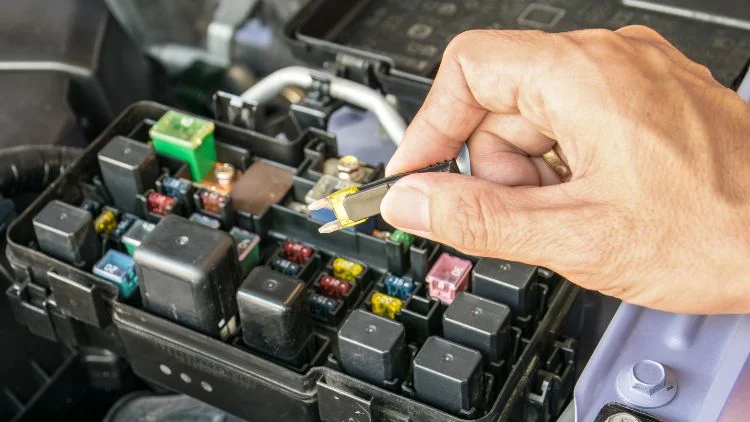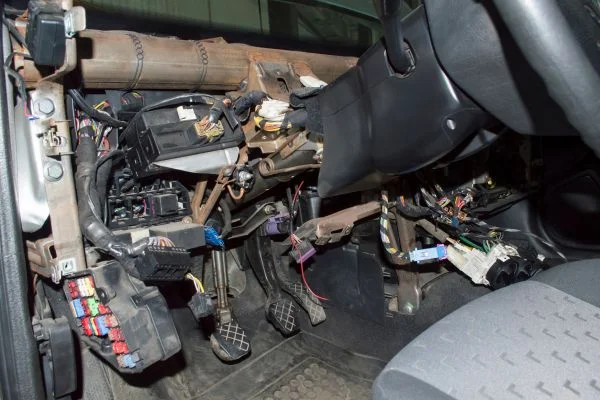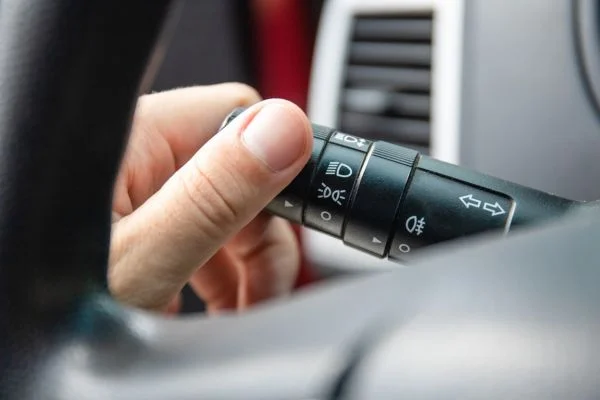Would you like to know How to test turn signal relay with multimeter? Don’t worry about that. Drivers need turn signals to signal intentions to other drivers. If turn signal isn’t working or blinking erratically, it’s probably a bad relay or something mysterious in the wiring. Testing turn signal relay is crucial for proper functioning and fixing problems with turn signal lights.
A Quick Look:
Set the multimeter to continuity or resistance mode. Find the turn signal relay in car’s fuse box. Take out the relay and check for damage or corrosion. Use the multimeter to test the relay’s resistance. If it’s in the right range, Relay should be fine. Put it back and test turn signals.
How Does the Turn Signal Relay Work?
The turn signal relay operates on the principle of electromechanical switching. It consists of several components, including an electromagnet, a set of contacts, and a coil. When you activate the turn signal, an electrical current flows through the relay coil, creating a magnetic field that attracts the connections, causing them to close.
This closure completes the circuit, allowing power to flow to the turn signal lights. As the current flows through the lights, the relay coil weakens, and the contacts open again, interrupting the circuit and turning off the lights. This on-off cycle continues as long as the turn signal is activated.
Components of a Typical Turn Signal Relay
A typical turn signal relay contains several vital components. These include:

Electromagnet: The electromagnet consists of a wire coil wound around a metal core. When an electrical current passes through the coil, it creates a magnetic field, which is crucial for the operation of the relay.
Contacts: The contacts are movable metal plates or switches within the relay. They make or break the electrical connection when the relay is activated or deactivated, respectively.
Coil: The wire winding within the relay generates the magnetic field when current flows through it. The strength of the magnetic field determines the operation of the relay contacts.
Read more about How to Test a Pickup Coil with Multimeter
Housing: The housing is the protective casing that encloses the relay’s internal components. It safeguards the relay from external elements and provides structural support.
Gather the Necessary Tools and Equipment
Before knowing the producer How to test turn signal relay with multimeter, ensure you have the necessary tools. you will need the following tools and equipment:

- Multimeter
- Screwdriver
- Safety Gloves
- Safety Glasses



Safety Precautions
When working with electrical components, it is crucial to prioritize safety. Before starting the test, follow these safety precautions:
Disconnect the Battery: Disconnect the battery by removing the negative terminal to prevent electrical mishaps.

Read more about How to test AGM battery with multimeter
This step will eliminate the risk of accidental shocks or short circuits during testing.
Allow Time for Cooling: If you’ve recently driven vehicle, allow sufficient time for the engine and electrical components to cool down. This precaution will protect you from potential burns and ensure accurate test results.
Read the Vehicle Manual: Consult vehicle’s manual for specific instructions on locating the turn signal relay. The manual will provide valuable information about the relay’s position and any additional precautions to be aware of during testing.

How to Test Turn Signal Relay with Multimeter?
Now that you’re prepared, it’s time to test the turn signal relay using a multimeter. This step-by-step process will help you diagnose any issues with the relay and determine its functionality.
Step 1: Locate the turn signal relay

The turn signal relay is typically located in the fuse box or under the dashboard. Consult vehicle’s manual or do a quick online search to find its exact location. If your car has wiring problems, take a look at this guide on How to Test Car Wiring with Multimeter?
Step 2: Prepare the multimeter

Set multimeter to the appropriate setting for resistance (ohms). This will allow you to measure the resistance of the relay.
Read more about5 Best Multimeter For Millivolts
Step 3: Disconnect the turn signal relay

You need to disconnect the turn signal relay from its socket to get an accurate reading. This may require removing some panels or covers to access the relay.
Step 4: Connect the multimeter probes

Connect the multimeter probes to the appropriate terminals on the turn signal relay. Usually, there are two or more terminals labeled “S” (signal), “B” (battery), and/or “L” (load).
Step 5: Measure the resistance
With the multimeter probes connected, read the resistance displayed on the multimeter. A healthy turn signal relay should have a low resistance value, typically around 10 to 100 ohms. If the reading is significantly higher or infinity, it indicates a faulty relay.
Step 6: Test continuity
You can also test the continuity of the turn signal relay by setting multimeter to the continuity mode (usually denoted by a sound or a diode symbol). Touch the probes to the relay terminals, and if you hear a beep or see the continuity indicator on the multimeter, it means the relay is functioning properly.
Step 7: Replace or repair the relay if necessary
If the multimeter readings indicate a faulty turn signal relay, it’s time to replace or repair it. Consult a professional or refer to vehicle’s manual for guidance on obtaining a new relay or repairing the existing one.
How do I know if my turn signal relay is bad?
First, check if turn signals are not working at all or are functioning inconsistently. If you notice that the turn signals do not light up when you engage them, or they blink rapidly or erratically, it could be a sign of a faulty relay. Additionally, you may hear unusual clicking sounds from the relay itself or notice that the turn signal indicator on dashboard stays illuminated without blinking.
If you experience any of these issues, Turn signal relay might need to be replaced. It’s recommended to consult with a professional mechanic for a proper diagnosis and repair.

Unusual clicking sounds from the relay or a constantly illuminated turn signal indicator on dashboard are signs of potential relay problems. However, it’s essential to remember that other electrical issues can also cause these symptoms. To accurately diagnose and address the problem, it’s best to seek assistance from a qualified mechanic who can inspect vehicle and provide the necessary repairs or replacements.
Summary
Learning How to test turn signal relay with multimeter can be straightforward if you pay some attention. Remember, safety is your top priority when working with electrical components. Ensure that the multimeter is in good condition. If not, then you may need professional help.
FAQs
How do you test a 12v flasher?
To test a 12V flasher, you can follow a few simple steps. First, make sure the flasher is disconnected from any power source. Then, use a multimeter set to the DC voltage range to measure the voltage across the flasher’s terminals. If you see a reading close to 12V, it indicates that the flasher is receiving power correctly.
Next, reconnect the flasher to a 12V power source and observe its behavior. If the flasher starts blinking at the expected rate, it suggests that it is functioning correctly. Additionally, you can visually inspect the flasher for any signs of damage or loose connections. Safety is essential when working with electrical components, so always exercise caution and refer to the manufacturer’s instructions if available.
How do you test a 4 pin 12v relay?
Testing a 4-pin 12V relay is a straightforward process that can help ensure its proper functionality. First, disconnect any power source to avoid any accidents. Start by visually inspecting the relay for any physical damage or loose connections. Then, placing the probes on the relay’s coil pins using a multimeter set to the continuity or resistance mode.
Apply 12 volts to the relay’s control terminals while observing the multimeter. If you hear a click sound and the resistance/continuity reading changes, congratulations! Relay is working! Conversely, if there’s no change, it may indicate a faulty relay.
How do you check if a relay is working?
To check if a relay is working, follow these simple steps. First, make sure the power supply is turned off for safety. Then, visually inspect the relay for any signs of damage or loose connections. Next, use a multimeter set to the resistance or continuity mode. Connect the multimeter leads to the relay’s coil terminals.
The coil is intact if the multimeter shows a low resistance or beeps. Finally, apply power to the relay and listen for a clicking sound, indicating that the relay is activating. If these tests pass, Relay is likely working fine.
Can you test a relay with a battery?
Yes, you can test a relay with a battery. A relay is an electrical switch that uses an electromagnet to control the flow of electricity. You can connect a battery to the relay’s coil terminals to try it. When the battery is connected, it should activate the electromagnet, which in turn should cause the relay’s contacts to close or open, depending on its design. This simple test can help you determine if the relay functions correctly and if its contacts work as intended.
It’s important to note that while testing a relay with a battery can give you a primary indication of its functionality, it may need to provide a comprehensive assessment. Factors such as the voltage and current requirements of the relay may affect its performance, and specialized testing equipment may be necessary for a more thorough evaluation.
How do you manually test a relay?
There are some people who ask How to test turn signal relay with multimeter and some people want to know how to manually test a relay. You need to see the template if you want to learn how to test with a multimeter. To manually test a relay, follow these simple steps.
First, ensure the relay is disconnected from any power source. Next, use a multimeter to measure the resistance across the relay’s coil terminals. If the reading is within the specified range, the coil functions correctly. Then, check the continuity of the relay’s contacts by connecting the multimeter probes to the contact terminals.
The contacts are working as expected if the meter shows continuity when the coil is energized and no continuity when it’s not. Finally, inspect the relay for any visible damage or overheating. By performing these tests, you can ensure relay is in good working condition.

